It looks like you're using an Ad Blocker.
Please white-list or disable AboveTopSecret.com in your ad-blocking tool.
Thank you.
Some features of ATS will be disabled while you continue to use an ad-blocker.
share:
reply to post by septic
I'm sorry, did I miss the part wherein you established that all the damage in those photos was caused exclusively by the impact and none of the damage and alignment of the damaged material was a result of the explosion that immeadiately followed the impact? Please link me to that post.
What answer? I ask what caused the left-to-right directional damage and all you can do is point to an aluminum spar? Have you demonstrated how a lightweight aluminum spar striking straight-on at a 35 degree wedge from the right can cause left to right damage of the 14 inch square steel box columns with two protruding, wing-slicing edges?
I'm sorry, did I miss the part wherein you established that all the damage in those photos was caused exclusively by the impact and none of the damage and alignment of the damaged material was a result of the explosion that immeadiately followed the impact? Please link me to that post.
reply to post by hooper
I am sure you missed most of the thread. I have explained my hypothesis and reasoning repeatedly. You are welcome to dispute it, and if you're saying a fuel air explosion from behind caused the left to right damage in both towers, okay, but you'd have to explain how a fuel air explosion would do that.
Aren't explosive charges usually placed directly on the steel they're trying to cut? Do not shaped charges use their directional blasts to use pressure to cut steel? How could the pressure of a fuel air explosion from behind bend the steel from both towers that way? The pressure from the blast was not concentrated and could easier escape around the columns, rather than through them, so it doesn't seem like the fuel air blast could account for the directional damage better than a kinetic energy weapon.
Here's a video demonstration of what I mean about the pressure:
I'm sorry, did I miss the part wherein you established that all the damage in those photos was caused exclusively by the impact and none of the damage and alignment of the damaged material was a result of the explosion that immeadiately followed the impact? Please link me to that post.
I am sure you missed most of the thread. I have explained my hypothesis and reasoning repeatedly. You are welcome to dispute it, and if you're saying a fuel air explosion from behind caused the left to right damage in both towers, okay, but you'd have to explain how a fuel air explosion would do that.
Aren't explosive charges usually placed directly on the steel they're trying to cut? Do not shaped charges use their directional blasts to use pressure to cut steel? How could the pressure of a fuel air explosion from behind bend the steel from both towers that way? The pressure from the blast was not concentrated and could easier escape around the columns, rather than through them, so it doesn't seem like the fuel air blast could account for the directional damage better than a kinetic energy weapon.
Here's a video demonstration of what I mean about the pressure:
reply to post by septic
Actually, there's not much to miss.
Not until you explain how you distinguished between damage caused by the impact and damage caused by the blast in your photos.
Sorry, the burden is all on you. Please show how you distinguished between the effects of the impact and the effects of the blast.
Well, I guess that pretty much seals this deal. What's next for you? Are you considering maybe exploring the old "all the victims are make believe" angle? That would seem an almost natural fit for you.
I am sure you missed most of the thread.
Actually, there's not much to miss.
I have explained my hypothesis and reasoning repeatedly.
Not until you explain how you distinguished between damage caused by the impact and damage caused by the blast in your photos.
You are welcome to dispute it, and if you're saying a fuel air explosion from behind caused the left to right damage in both towers, okay, but you'd have to explain how a fuel air explosion would do that.
Sorry, the burden is all on you. Please show how you distinguished between the effects of the impact and the effects of the blast.
Well, I guess that pretty much seals this deal. What's next for you? Are you considering maybe exploring the old "all the victims are make believe" angle? That would seem an almost natural fit for you.
reply to post by hooper
If you're here for an argument, or to pretend you are the grand inquisitor, this isn't the place, and I'm not the guy.
The evidence I've provided supports the premise completely. If you disagree you can take a crack at explaining how I am mistaken. If you think it was a fuel air explosion, that's your bailiwick, I'm all ears.
If you're here for an argument, or to pretend you are the grand inquisitor, this isn't the place, and I'm not the guy.
The evidence I've provided supports the premise completely. If you disagree you can take a crack at explaining how I am mistaken. If you think it was a fuel air explosion, that's your bailiwick, I'm all ears.
Originally posted by snowcrash911
What did I say? And did I ask you?
Originally posted by snowcrash911
Could you explain how the water is able to cut the steel, septic? (I already know, just explain it)
Who cares who you asked? This is a public forum, you got your answer. Why you asked it when you already claim to know I'm not sure, but it didn't make the point you thought it did.
Obviously you don't like the answer? Did you think it was simply the speed of the water lol?
Originally posted by snowcrash911
Answer the question. How does it work? How can water cut steel but steel not be cut by aluminum?
I guess you really didn't understand the answer I gave after all? It's not just water, it is water forced, by an external source, to create pressure between the source, and the material to be cut.
Pressure, abrasives, and a very fine orifice creating a very fine highly pressurized jet of abrasive water. That takes time to cut, it doesn't impact the steel and just go straight through. It creates micro erosion of the steel.
If you were to simply throw water at 500mph at the steel, it would do nothing to the steel.
If the planes could have created 50,000 PSI on the towers steel, then it would have been a different story.
Most waterjet cutting theories explain waterjet cutting as a form of micro erosion as described here. Waterjet cutting works by forcing a large volume of water through a small orifice in the nozzle. The constant volume of water traveling through a reduced cross sectional area causes the particles to rapidly accelerate. This accelerated stream leaving the nozzle impacts the material to be cut. The extreme pressure of the accelerated water particles contacts a small area of the work piece. In this small area the work piece develops small cracks due to stream impact. The waterjet washes away the material that "erodes" from the surface of the work piece. The crack caused by the waterjet impact is now exposed to the waterjet. The extreme pressure and impact of particles in the following stream cause the small crack to propagate until the material is cut through.
www.mfg.mtu.edu...
So please stop the distractions with questions you could answer yourself with a little research. You're not going to stump 'truthers' with this nonsense.
edit on 12/6/2011 by ANOK because: typo
reply to post by septic
No, I'm here for the wonderful music and the food.
In other words, you're not going to answer any questions or explain anything. Ok, got it. You're a one-way street.
Huh? This isn't the place for a debate?
Yes, I think we all realize you're not the type to answer questions about your "claims".
Sorry, but there is this huge crack in your evidence. You see, you posted photos of structural damage to a building that was subject to both a plane impact and huge explosion and either can't or refuse to tell us how you distinguished between the effects of the two.
Its quite simple. The damaged area was subjected to both mechanical impact and explosive force. You are looking at the pattern of the damage and extraploting a cause and refuse to distinguish between the damage caused by the explosion and damage caused by impact.
I THINK there was a fuel air explosion??? Are you now denying that there was an explosion? This is a whole new level of denial. Very interesting.
If you're here for an argument,
No, I'm here for the wonderful music and the food.
or to pretend you are the grand inquisitor,
In other words, you're not going to answer any questions or explain anything. Ok, got it. You're a one-way street.
this isn't the place....
Huh? This isn't the place for a debate?
....and I'm not the guy.
Yes, I think we all realize you're not the type to answer questions about your "claims".
The evidence I've provided supports the premise completely.
Sorry, but there is this huge crack in your evidence. You see, you posted photos of structural damage to a building that was subject to both a plane impact and huge explosion and either can't or refuse to tell us how you distinguished between the effects of the two.
If you disagree you can take a crack at explaining how I am mistaken.
Its quite simple. The damaged area was subjected to both mechanical impact and explosive force. You are looking at the pattern of the damage and extraploting a cause and refuse to distinguish between the damage caused by the explosion and damage caused by impact.
If you think it was a fuel air explosion, that's your bailiwick, I'm all ears
I THINK there was a fuel air explosion??? Are you now denying that there was an explosion? This is a whole new level of denial. Very interesting.
reply to post by hooper
Wow, aren't you a hormone with an attitude. I bet you were bullied as a child. Are you a cop now?
You ignored my answers and then accuse me of not answering. Here's where I responded to your absurd notion that a fuel-air explosion caused the damage.
Pull out your head, and scroll up.
Man, you're obviously only here to pick a fight.
I've included pictures for folks like you who can't read, but just to clarify, I was disputing your claim that the left-to-right damage could have been caused by the secondary fuel-air explosion from the rear. Only in your adolescent imagination was anyone disputing the fuel-air explosion's existence.
Get over yourself. I was serious about ignoring buffoons who can't read and refuse to acknowledge my responses to their idiotic questions. Let this be a reminder to you and your team mates.
Sorry, but there is this huge crack in your evidence. You see, you posted photos of structural damage to a building that was subject to both a plane impact and huge explosion and either can't or refuse to tell us how you distinguished between the effects of the two.
Wow, aren't you a hormone with an attitude. I bet you were bullied as a child. Are you a cop now?
You ignored my answers and then accuse me of not answering. Here's where I responded to your absurd notion that a fuel-air explosion caused the damage.
Originally posted by septic
reply to post by hooper
I'm sorry, did I miss the part wherein you established that all the damage in those photos was caused exclusively by the impact and none of the damage and alignment of the damaged material was a result of the explosion that immeadiately followed the impact? Please link me to that post.
I am sure you missed most of the thread. I have explained my hypothesis and reasoning repeatedly. You are welcome to dispute it, and if you're saying a fuel air explosion from behind caused the left to right damage in both towers, okay, but you'd have to explain how a fuel air explosion would do that.
Aren't explosive charges usually placed directly on the steel they're trying to cut? Do not shaped charges use their directional blasts to use pressure to cut steel? How could the pressure of a fuel air explosion from behind bend the steel from both towers that way? The pressure from the blast was not concentrated and could easier escape around the columns, rather than through them, so it doesn't seem like the fuel air blast could account for the directional damage better than a kinetic energy weapon.
Here's a video demonstration of what I mean about the pressure:
Its quite simple. The damaged area was subjected to both mechanical impact and explosive force. You are looking at the pattern of the damage and extraploting a cause and refuse to distinguish between the damage caused by the explosion and damage caused by impact.
Pull out your head, and scroll up.
I THINK there was a fuel air explosion??? Are you now denying that there was an explosion? This is a whole new level of denial. Very interesting.
Man, you're obviously only here to pick a fight.
I've included pictures for folks like you who can't read, but just to clarify, I was disputing your claim that the left-to-right damage could have been caused by the secondary fuel-air explosion from the rear. Only in your adolescent imagination was anyone disputing the fuel-air explosion's existence.
Get over yourself. I was serious about ignoring buffoons who can't read and refuse to acknowledge my responses to their idiotic questions. Let this be a reminder to you and your team mates.
reply to post by septic
Nice long post but an obvious side-step. A paragraph about the theory of shape charges does not explain how you distinguished between the damage done by the impact and damage done by the explosion. Oh, and by the way your incredulity regarding the possibility that a similar explosion in a similar building may result in similar damage does not explain how you distinguished the difference in the damage.
Ok, this is the point where you ignore everything I asked, call my a buffoon and huff away saying you're not here to argue - you just want everyone to take your word for everything and then will all be in a better place.
Nice long post but an obvious side-step. A paragraph about the theory of shape charges does not explain how you distinguished between the damage done by the impact and damage done by the explosion. Oh, and by the way your incredulity regarding the possibility that a similar explosion in a similar building may result in similar damage does not explain how you distinguished the difference in the damage.
Ok, this is the point where you ignore everything I asked, call my a buffoon and huff away saying you're not here to argue - you just want everyone to take your word for everything and then will all be in a better place.
Originally posted by hooper
reply to post by septic
Nice long post but an obvious side-step. A paragraph about the theory of shape charges does not explain how you distinguished between the damage done by the impact and damage done by the explosion. Oh, and by the way your incredulity regarding the possibility that a similar explosion in a similar building may result in similar damage does not explain how you distinguished the difference in the damage.
Ok, this is the point where you ignore everything I asked, call my a buffoon and huff away saying you're not here to argue - you just want everyone to take your word for everything and then will all be in a better place.
Was that your way of stating your case, whatever it is?
edit on 7-12-2011 by septic because: (no reason given)
reply to post by septic
Case? What case? I'm not stating a case - I am just trying to get you to answer a real simple, straightforward question about your "case".
Repeat:
How did you distinguish between the damage done to the structure by the impact of the plane and the damage that was a result of the subsequent explosion? Since the pattern of the damage is the foundation of your claim, then you must have established a fool proof method for distinguishing between the two, corrrect?
Was that your way of stating your case, whatever it is?
Case? What case? I'm not stating a case - I am just trying to get you to answer a real simple, straightforward question about your "case".
Repeat:
How did you distinguish between the damage done to the structure by the impact of the plane and the damage that was a result of the subsequent explosion? Since the pattern of the damage is the foundation of your claim, then you must have established a fool proof method for distinguishing between the two, corrrect?
reply to post by hooper
The damage done to the structure is clearly directional, caused by something small enough, and dense enough, and with enough mass to punch through multiple columns, bending them to the right. I came to this conclusion after researching the only available images and movies of the damage to tower 1, and subsequently noticed the same pattern on tower 2. I know it's directional because anyone who has ever hit anything with a hammer, or hit a picket fence with a stick, can see something hard hit those columns in a left to right trajectory. It is self evident.
A jet wing being struck by the heavy steel building at 500 MPH would be turned to confetti, save say the engines and landing gear. The wing was going in the wrong direction and anyone looking at a jet crash video knows how massive they are. The tips of the wings cannot account for the directional damage as shown below.

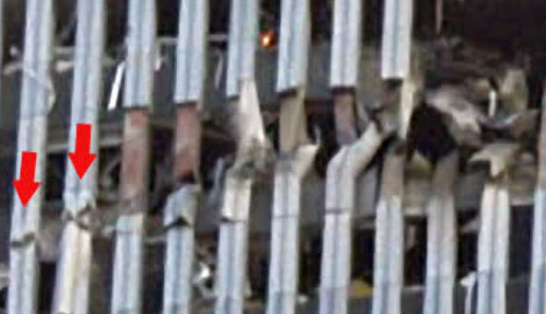
I discount a secondary explosion because of the requirements of cutting the 14" square 1/4 inch steel columns with explosives. A fuel air explosion would not damage the heavy columns with the sharp, angular dents towards the epicenter of the blast, even if the fuel air explosion contained enough directional pressure, as explained to you earlier. This is why I also discount shaped charges as being able to cause the damage. Aside from the preparation required for linear shaped charges, looking at the damage, the easiest way to explain it is with a kinetic energy weapon, while the damage to column 144 appears to be due to the 200lb of explosives detonating after the missile passed through a few columns.
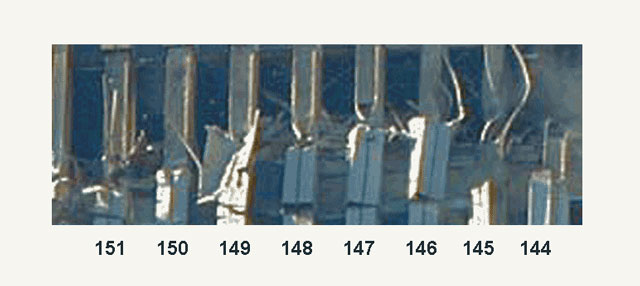
So if a jet can't be the explanation, and shaped charges wouldn't cause the directional damage, what can explain it?
The 60 inch x 12 inch 900 lb penetrating warhead of a JASSM missile fits the bill. On the left sides of the buildings, the trajectory was upwards and inwards, and they didn't have enough energy to completely sever the columns like they did on the right:
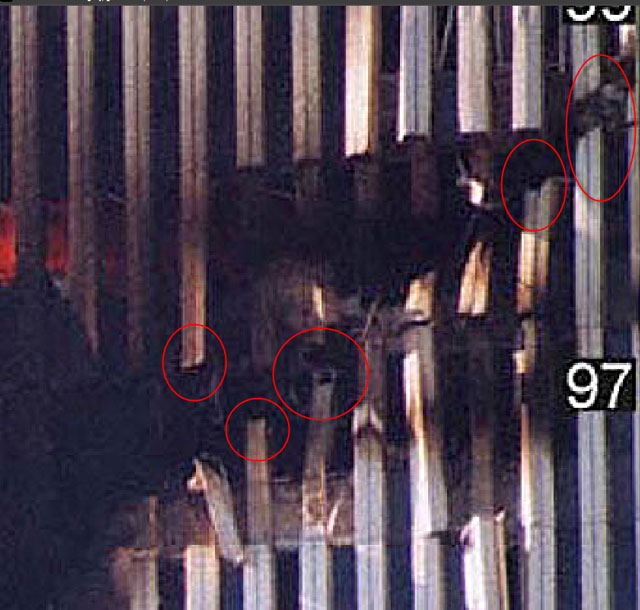
How did you distinguish between the damage done to the structure by the impact of the plane and the damage that was a result of the subsequent explosion?
The damage done to the structure is clearly directional, caused by something small enough, and dense enough, and with enough mass to punch through multiple columns, bending them to the right. I came to this conclusion after researching the only available images and movies of the damage to tower 1, and subsequently noticed the same pattern on tower 2. I know it's directional because anyone who has ever hit anything with a hammer, or hit a picket fence with a stick, can see something hard hit those columns in a left to right trajectory. It is self evident.
A jet wing being struck by the heavy steel building at 500 MPH would be turned to confetti, save say the engines and landing gear. The wing was going in the wrong direction and anyone looking at a jet crash video knows how massive they are. The tips of the wings cannot account for the directional damage as shown below.


I discount a secondary explosion because of the requirements of cutting the 14" square 1/4 inch steel columns with explosives. A fuel air explosion would not damage the heavy columns with the sharp, angular dents towards the epicenter of the blast, even if the fuel air explosion contained enough directional pressure, as explained to you earlier. This is why I also discount shaped charges as being able to cause the damage. Aside from the preparation required for linear shaped charges, looking at the damage, the easiest way to explain it is with a kinetic energy weapon, while the damage to column 144 appears to be due to the 200lb of explosives detonating after the missile passed through a few columns.

So if a jet can't be the explanation, and shaped charges wouldn't cause the directional damage, what can explain it?
The 60 inch x 12 inch 900 lb penetrating warhead of a JASSM missile fits the bill. On the left sides of the buildings, the trajectory was upwards and inwards, and they didn't have enough energy to completely sever the columns like they did on the right:

reply to post by septic
Of course, you haven't any evidence and your explanations of the damage are confusing. Columns 145 and 146, which you noted in the OP, seem to have the two flanges pushed to the right. As this was the left wing, why is this inconsistent? The wing would strike the right edge first and push it to the right, tearing the flange from the box member and twisting the column to the right. Then it would impact the left edge and twist the column further to the right.
No invisible missile needed.
Of course, you haven't any evidence and your explanations of the damage are confusing. Columns 145 and 146, which you noted in the OP, seem to have the two flanges pushed to the right. As this was the left wing, why is this inconsistent? The wing would strike the right edge first and push it to the right, tearing the flange from the box member and twisting the column to the right. Then it would impact the left edge and twist the column further to the right.
No invisible missile needed.
Originally posted by alwayssmile2
I like the response of the wing of the plane. lol
I know...it cracked me up too.
Originally posted by pteridine
reply to post by septic
Of course, you haven't any evidence and your explanations of the damage are confusing. Columns 145 and 146, which you noted in the OP, seem to have the two flanges pushed to the right. As this was the left wing, why is this inconsistent? The wing would strike the right edge first and push it to the right, tearing the flange from the box member and twisting the column to the right. Then it would impact the left edge and twist the column further to the right.
No invisible missile needed.
I understand why you and the other ATS stalwarts are so reluctant to debate me. Your scripts are so limited.
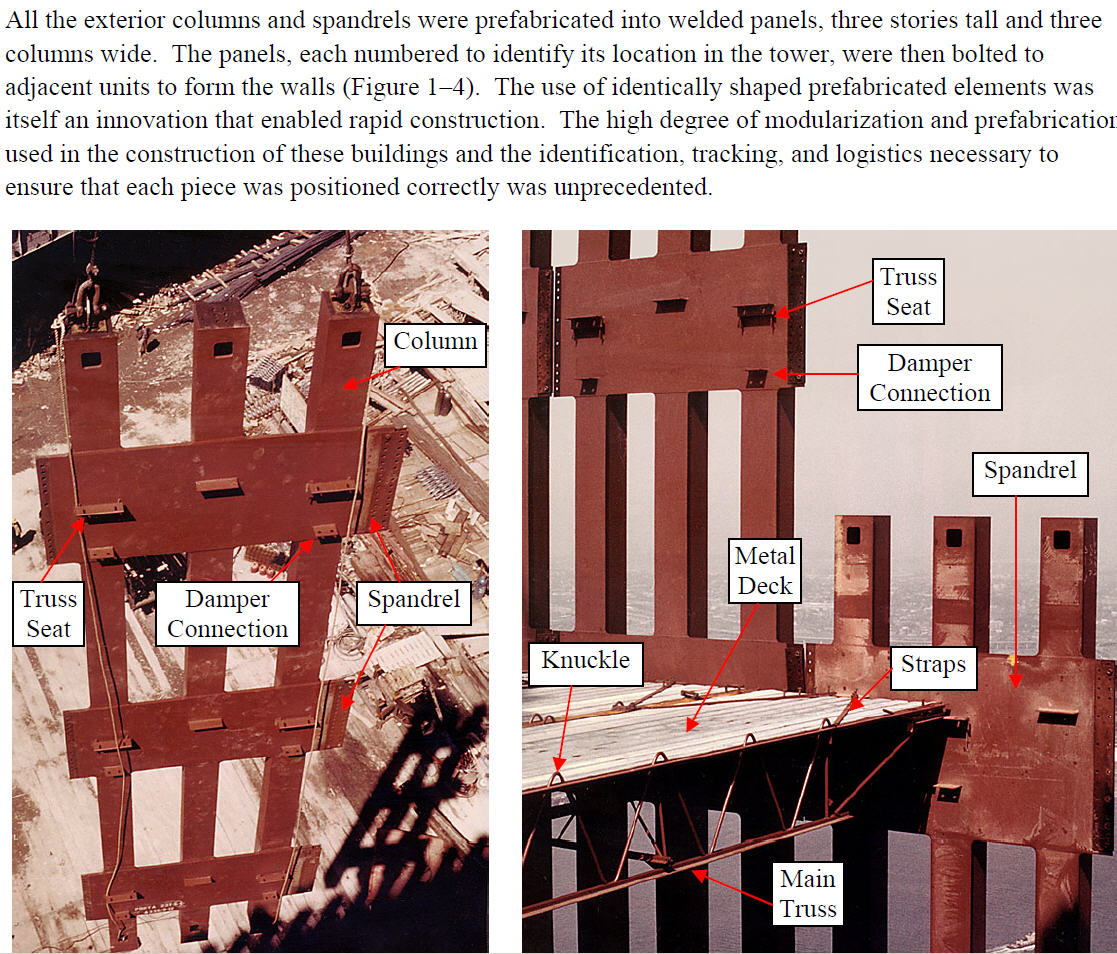

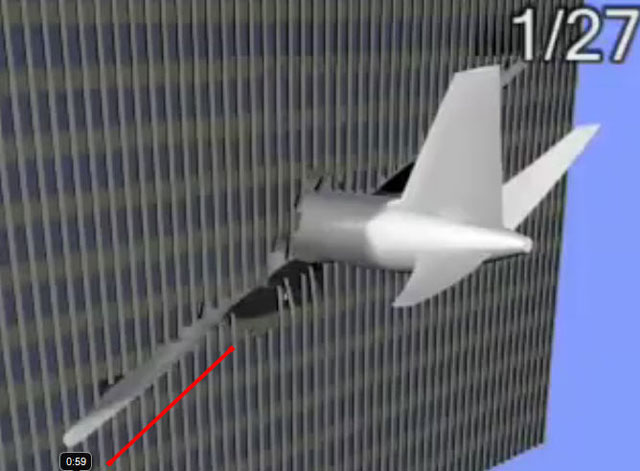

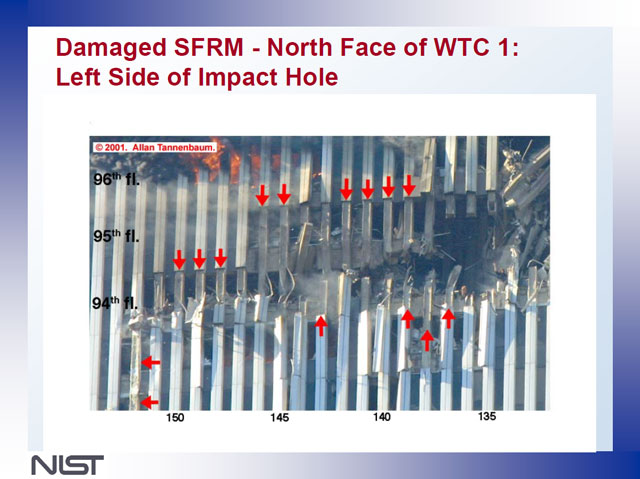
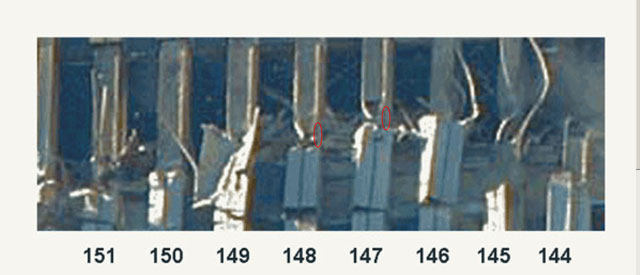
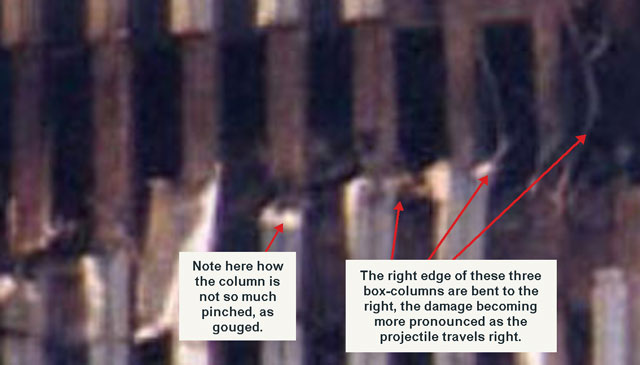


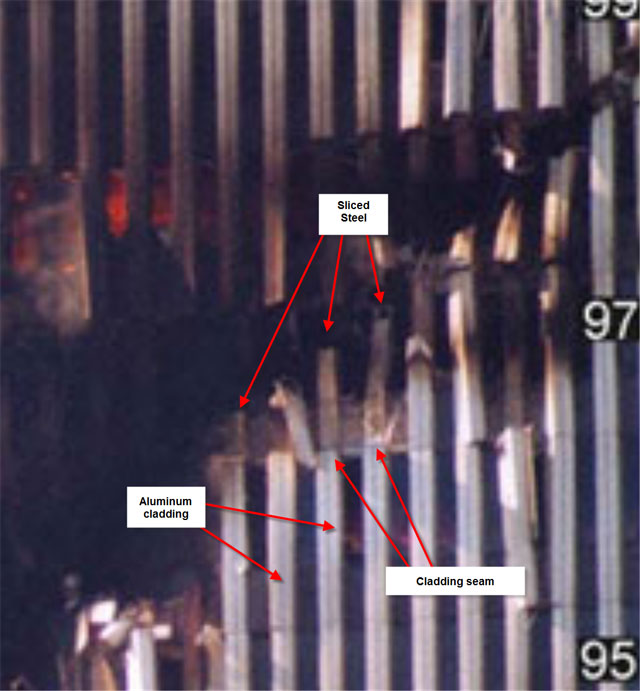
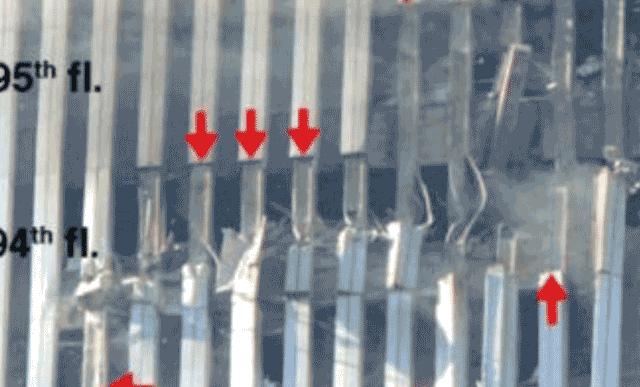
edit on 9-12-2011 by septic because: (no reason given)
Originally posted by septic
Originally posted by pteridine
reply to post by septic
Of course, you haven't any evidence and your explanations of the damage are confusing. Columns 145 and 146, which you noted in the OP, seem to have the two flanges pushed to the right. As this was the left wing, why is this inconsistent? The wing would strike the right edge first and push it to the right, tearing the flange from the box member and twisting the column to the right. Then it would impact the left edge and twist the column further to the right.
No invisible missile needed.
I understand why you and the other ATS stalwarts are so reluctant to debate me. Your scripts are so limited.
So far you haven't provided any content to debate.
All you can say is that you don't believe that the wing can cut steel because you have little understanding of the dynamics of such a collision. Given the witnesses to the aircraft, video records and physical evidence of aircraft collisions, you are in a bit of a corner. You have to come up with something that can do the job. You randomly select a cruise missile as your explanation and say that it will scrape nice straight lines without exploding and then explode just so that it looks like airplanes cut through the steel. I think you may have called for seven invisible missiles. You talk about shaped charges and show a demo that doesn't have applicability to the damage on the buildings. You claimed there were no people in the building, no companies rented space, and the buildings were empty. Of course, you have shown no evidence for any of this. You also said that there were no planes and people didn't see any planes. You refuse to show evidence for anything you claim and have lifted all of this theory, including diagrams, from another website and reposted it on ATS.
Maybe that is why you are at a loss to show any evidence. There isn't any.
reply to post by pteridine
So, for the readers' sakes lets recap:
1 - directional damage to both towers indicates a physical impact in a left-to-right pattern.
2 - the directional damage is impossible to have been caused by a round-edged aluminum wing tip traveling in a different direction.
3 - every attempt to prove a lightweight jet wing could account for the damage has failed.
4 - witnesses reported bombs and missiles and small planes at first, but that story changed when the TV broadcast jets.
5 - every image containing a jet has been proven to be fraudulent.
So, for the readers' sakes lets recap:
1 - directional damage to both towers indicates a physical impact in a left-to-right pattern.
2 - the directional damage is impossible to have been caused by a round-edged aluminum wing tip traveling in a different direction.
3 - every attempt to prove a lightweight jet wing could account for the damage has failed.
4 - witnesses reported bombs and missiles and small planes at first, but that story changed when the TV broadcast jets.
5 - every image containing a jet has been proven to be fraudulent.
Originally posted by septic
reply to post by pteridine
So, for the readers' sakes lets recap:
1 - directional damage to both towers indicates a physical impact in a left-to-right pattern.
2 - the directional damage is impossible to have been caused by a round-edged aluminum wing tip traveling in a different direction.
3 - every attempt to prove a lightweight jet wing could account for the damage has failed.
4 - witnesses reported bombs and missiles and small planes at first, but that story changed when the TV broadcast jets.
5 - every image containing a jet has been proven to be fraudulent.
So - how did you distinguish between the damage caused by the impact and the damage caused by the explosion?
This question isn't going away.
Originally posted by hooper
Originally posted by septic
reply to post by pteridine
So, for the readers' sakes lets recap:
1 - directional damage to both towers indicates a physical impact in a left-to-right pattern.
2 - the directional damage is impossible to have been caused by a round-edged aluminum wing tip traveling in a different direction.
3 - every attempt to prove a lightweight jet wing could account for the damage has failed.
4 - witnesses reported bombs and missiles and small planes at first, but that story changed when the TV broadcast jets.
5 - every image containing a jet has been proven to be fraudulent.
So - how did you distinguish between the damage caused by the impact and the damage caused by the explosion?
This question isn't going away.
Neither are my responses. Is this the best you can do; keep asking the same thing, over, and over again?
I answered you first here, which you ignored, so I answered it again here.
new topics
-
Those Great Fresh Pet Commercials
Television: 1 hours ago -
S.C. Jack Smith's Final Report Says Trump Leads a Major Conspiratorial Criminal Organization!.
Political Conspiracies: 3 hours ago -
Advice for any young Adult .
General Chit Chat: 4 hours ago -
Joe meant what he said about Hunter's pardon....
US Political Madness: 5 hours ago -
Regent Street in #London has been evacuated due to a “bomb threat.”
Other Current Events: 5 hours ago -
It’s Falling…
Philosophy and Metaphysics: 7 hours ago -
Steering the Titantic from the Drydock.
Rant: 10 hours ago
top topics
-
Steering the Titantic from the Drydock.
Rant: 10 hours ago, 10 flags -
Joe meant what he said about Hunter's pardon....
US Political Madness: 5 hours ago, 10 flags -
Advice for any young Adult .
General Chit Chat: 4 hours ago, 7 flags -
S.C. Jack Smith's Final Report Says Trump Leads a Major Conspiratorial Criminal Organization!.
Political Conspiracies: 3 hours ago, 7 flags -
It’s Falling…
Philosophy and Metaphysics: 7 hours ago, 4 flags -
Regent Street in #London has been evacuated due to a “bomb threat.”
Other Current Events: 5 hours ago, 3 flags -
Those Great Fresh Pet Commercials
Television: 1 hours ago, 2 flags
active topics
-
Advice for any young Adult .
General Chit Chat • 11 • : Fowlerstoad -
Los Angeles brush fires latest: 2 blazes threaten structures, prompt evacuations
Mainstream News • 41 • : xuenchen -
President Carter has passed
Mainstream News • 42 • : UpIsNowDown2 -
Planned Civil War In Britain May Be Triggered Soon
Social Issues and Civil Unrest • 17 • : AlexandrosOMegas -
Claim: General Mark Milley Approved Heat and Sound Directed Energy Weapons During 2020 Riots
Whistle Blowers and Leaked Documents • 29 • : fringeofthefringe -
S.C. Jack Smith's Final Report Says Trump Leads a Major Conspiratorial Criminal Organization!.
Political Conspiracies • 20 • : BeyondKnowledge3 -
Steering the Titantic from the Drydock.
Rant • 41 • : Scratchpost -
Those Great Fresh Pet Commercials
Television • 2 • : AlroyFarms -
What Comes After January 20th
Mainstream News • 25 • : NorthOS -
Paramilitary Leaks - John Williams
Whistle Blowers and Leaked Documents • 11 • : xuenchen
